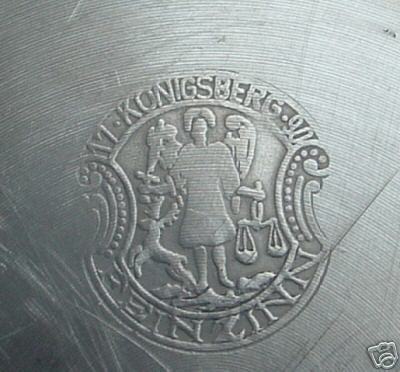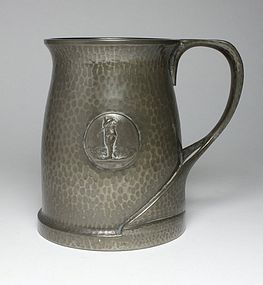Pewterers’ marks fall into five broad categories: touch marks, hallmarks, quality marks, labels and catalogue numbers. Below is an example of the marks of a pewterer who used four of these five types of marks (touch mark, hallmark, quality mark and a label).
For most pewter, the best guide to pewterers’ marks is Cotterell’s Old Pewter: It’s Makers and Marks. However, it is not complete as many more marks have been recorded since it was written, and some of the information in the book is now known to be incorrect.
For wares made in Sheffield of Britannia metal, Scott’s Pewter Wares from Sheffield, has a comprehensive list of pewterers’ marks.
Touch marks
A touch mark is a pewterer’s “trade mark” and often, but not always, includes the name or initials of the pewterer. In London and Edinburgh pewterers had to record their touch marks on special plates, and we know the names of most of those who did so. However, that practice was not followed elsewhere, and so whilst thousands of touch marks have been recorded, we do not always know the pewterers to whom they belong.
Touch marks vary considerably in style and size. If a touch mark includes a date, this is the date on which the pewterer set up in business, not the date on which the article was made.
Pseudo-hallmarks
When brand new and highly polished, pewter looks very much like silver, and many pewterers stamped pseudo-hallmarks on their wares to mimic the hallmarks on silver. Whilst hallmarks on pewter can help identify the pewterer, they have no “official” significance, unlike hallmarks on silver. There are normally four hallmarks, but pewterers from Wigan often used five, whilst very occasionally other pewterers used just three. The hallmarks often include the pewterer’s initials. Sometimes all four hallmarks are the same.
Quality marks
The crowned rose was used on pewter from the mid 16th century to denote quality. Most pewterers had their own variation of the design. Later, pewterers also used a crowned X to indicate that the metal was of a certain standard, but by the 18th century all control over the use of the mark was lost and pewterers were using it indiscriminately.
Before the introduction of the crowned rose, a crowned or uncrowned hammer was sometimes struck on sadware and this is also believed to be a quality mark. However, it is very rare.
Labels
In the 18th and 19th centuries many pewterers put various labels on their wares. Some were essentially advertising slogans, such as “Superfine Hard Metal” to promote the idea that the goods were of a superior quality. Others such as “Made in London” identified where the pewter was supposedly made, but be warned: this description was applied not only by London pewterers but also by many provincial pewterers, and indeed even by some on mainland Europe. This is because traditionally London pewter was considered to be superior.
Catalogue numbers
In the 19th and 20th century pewterers often produced catalogues of their wares and put the catalogue numbers on the articles themselves. They are normally simple stamped numbers of three, four or five digits, sometimes with a letter as well. They are most common on wares made of Britannia metal.
New collectors learn by experience but it is useful to look out for:
Condition
The better the condition of any piece, the more desirable it is. This does not mean to say that there should not be signs of use or wear, which in themselves add to interest. It is more important to look out for damage and repairs, for example handles and lids in hollow-ware that have been repaired or replaced or holes that have been filled in on flatware.
Again, repairs can be acceptable, especially on rare items but the collector should be aware and if possible show pieces to other collectors for more expert opinion.
Marks
Maker’s marks, verification marks and ownership marks all add tremendous interest and often value to any item.
Pewter is frequently found without a single mark, top, bottom, inside or out. But much is laden with a wide variety of intriguing numbers, letters, words, and symbols that provides clues to maker, age, origin, and use. The following is an introduction to British pewter marks with references for pewter marks on pieces from mainland Europe and America.
British pewter may carry one or more of the following types of marks:
- Pewterer’s marks
- Verification marks
- Ownership marks
- Merchant’s marks
Pewterers’ marks fall into five broad categories: touch marks, hallmarks, quality marks, labels and catalogue numbers. Below is an example of the marks of a pewterer who used four of these five types of marks (touch mark, hallmark, quality mark and a label).

For most pewter, the best guide to pewterers’ marks is Cotterell’s Old Pewter: It’s Makers and Marks. However, it is not complete as many more marks have been recorded since it was written, and some of the information in the book is now known to be incorrect.
For wares made in Sheffield of Britannia metal, Scott’s Pewter Wares from Sheffield, has a comprehensive list of pewterers’ marks.
Pseudo-hallmarks
When brand new and highly polished, pewter looks very much like silver, and many pewterers stamped pseudo-hallmarks on their wares to mimic the hallmarks on silver. Whilst hallmarks on pewter can help identify the pewterer, they have no “official” significance, unlike hallmarks on silver. There are normally four hallmarks, but pewterers from Wigan often used five, whilst very occasionally other pewterers used just three. The hallmarks often include the pewterer’s initials. Sometimes all four hallmarks are the same.
![]()
James Trew of London
1673 – c1680

Townsend & Compton of London
1784 – 1802
Labels
In the 18th and 19th centuries many pewterers put various labels on their wares. Some were essentially advertising slogans, such as “Superfine Hard Metal” to promote the idea that the goods were of a superior quality. Others such as “Made in London” identified where the pewter was supposedly made, but be warned: this description was applied not only by London pewterers but also by many provincial pewterers, and indeed even by some on mainland Europe. This is because traditionally London pewter was considered to be superior.
 |  |  |
Robert Porteus of London 1762 – ? | Birch & Villers of Birmingham late 18th century | George Holmes of London 1743 – ? |
Catalogue numbers
In the 19th and 20th century pewterers often produced catalogues of their wares and put the catalogue numbers on the articles themselves. They are normally simple stamped numbers of three, four or five digits, sometimes with a letter as well. They are most common on wares made of Britannia metal.
Verification and Capacity Marks
Verification and capacity marks only appear on measures of capacity. A capacity mark (such as “pint”) is self explanatory. A verification mark signifies that the measure has been officially inspected and found to be of the correct capacity. Between 1826 and about 1878 each town generally had its own style of mark, but thereafter a uniform style was adopted consisting of a crown, the monarch’s initials (ie VR or ER) and a number which signifies the location. Measures were often inspected several times during their lifetime and thus can carry several verification marks.
Prior to the introduction of the Imperial Standard in 1826, a “crowned WR” mark was sometimes used to indicate that the measure was made to the William III ale standard. The mark was usually applied by the pewterer, not by an inspector.
For a guide to verification marks, see Ricketts’ Marks and Markings of Weights and Measures of the British Isles.

Pre-1878

Post-1878
Ownership Marks
Owners often applied their own marks to pewter, particularly on sadware. The most common is a simple triad of initials stamped on the rim, the centre initial being the surname and the other two the forenames of the husband and wife. However, some owners had crests or shields engraved on their pewter.
Pub pots of the 19th and 20th century often have the pub name and address inscribed on the underside.
Marks on pewter from the European mainland
As a general rule, in mainland Europe the marking of pewter was more tightly controlled. by the local guilds than in Britain. The style of mark often identifies the town, and indeed often includes the emblem or arms of the town.
Dates in such marks have nothing to do with the pewterer. They simply indicate the date of the relevant guild regulations, which in some instances may have been introduced 200 years earlier.
For a bibliography of books on European pewter marks, see Gadd’s Books on European Pewter Marks.
Books on European Pewter Marks, Jan Gadd, 1999, ISBN 0 9508658 8 5. A comprehensive list of all the principle source books for European Pewterers’ touches, with analyses and comments. This and other publications are available to purchase from the Pewter Society.
Identification of Individual Items of Pewter
‘The Pewter Society is willing to help members of the public identify individual items of pewter if we can. This service is free, but it is NOT available to dealers nor to individuals if the sole purpose of the identification is to facilitate the sale of the item.
Please e-mail a photograph of the item as a whole, plus good close-up images of any marks on it. A narrative description of the item with dimensions, etc. and information on where it came from would also help. Please tell us which part of the world you come from, because that may help to identify the likely provenance. Although we will try, we cannot guarantee to identify marks because sometimes this could take hours of research. In any case, many marks are as yet unrecorded or unidentified.
Our main expertise is in British and Irish pewter, but in some cases we can also help with pewter from continental Europe or North America . We are unlikely to be able to help with pewter from elsewhere in the world.
Our main expertise is also in pewter over 100 years old. We are unlikely to be able to help with pewter that is later than 1910 and there are no books on more-recent pewter. We may be able to help with Art Nouveau pewter, Liberty/Tudric, Kaiserzinn, etc., though you will probably be better talking with an Art Nouveau specialist.’
Marks on American pewter
American pewterers used touch marks, quality marks and, occasionally, hallmarks that are broadly similar to those used by British pewterers.
Ledly I. Laughlin has written an excellent guide to Pewter In America.
Pewter In America; Its Makers and Their Marks Ledly I. Laughlin, Barre Publishers, Barre, Massachusetts, 1981, ISBN 0 517 350637. Three volumes in-one.




















